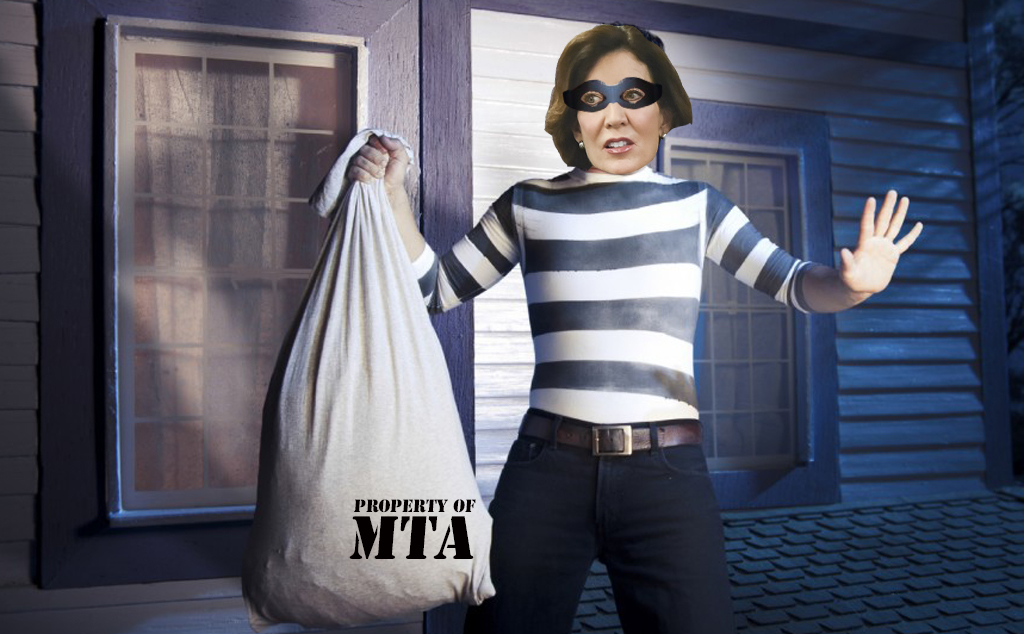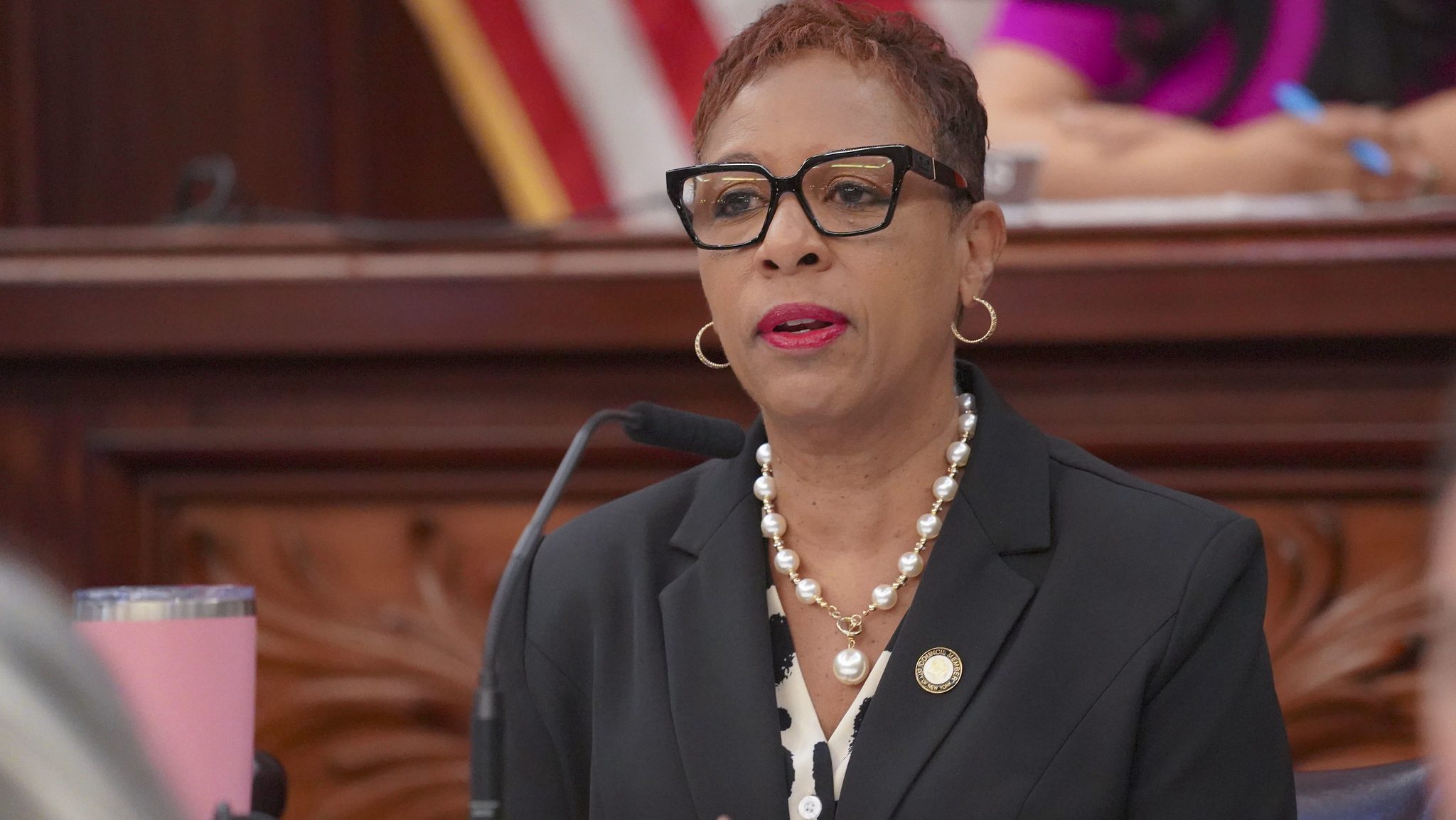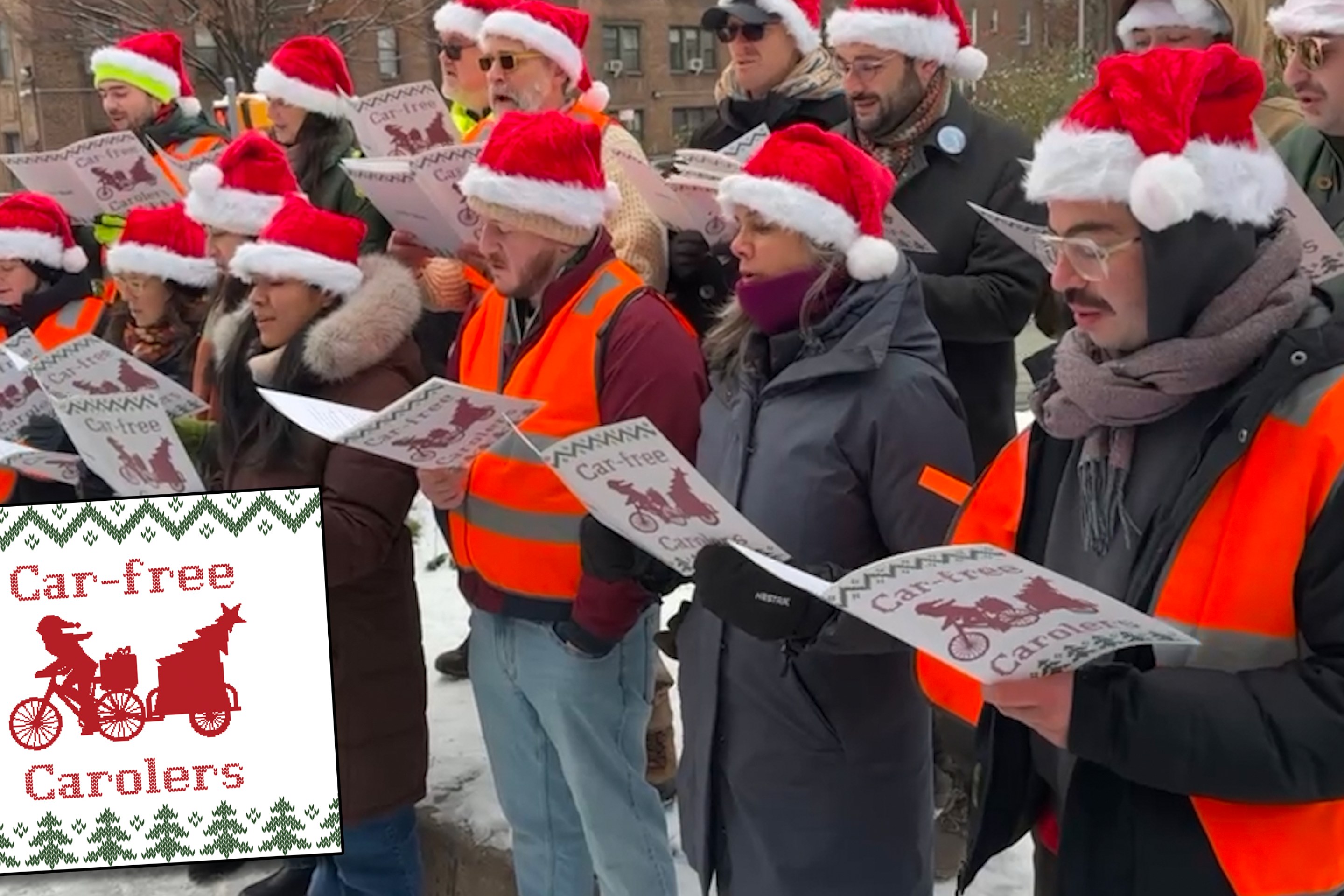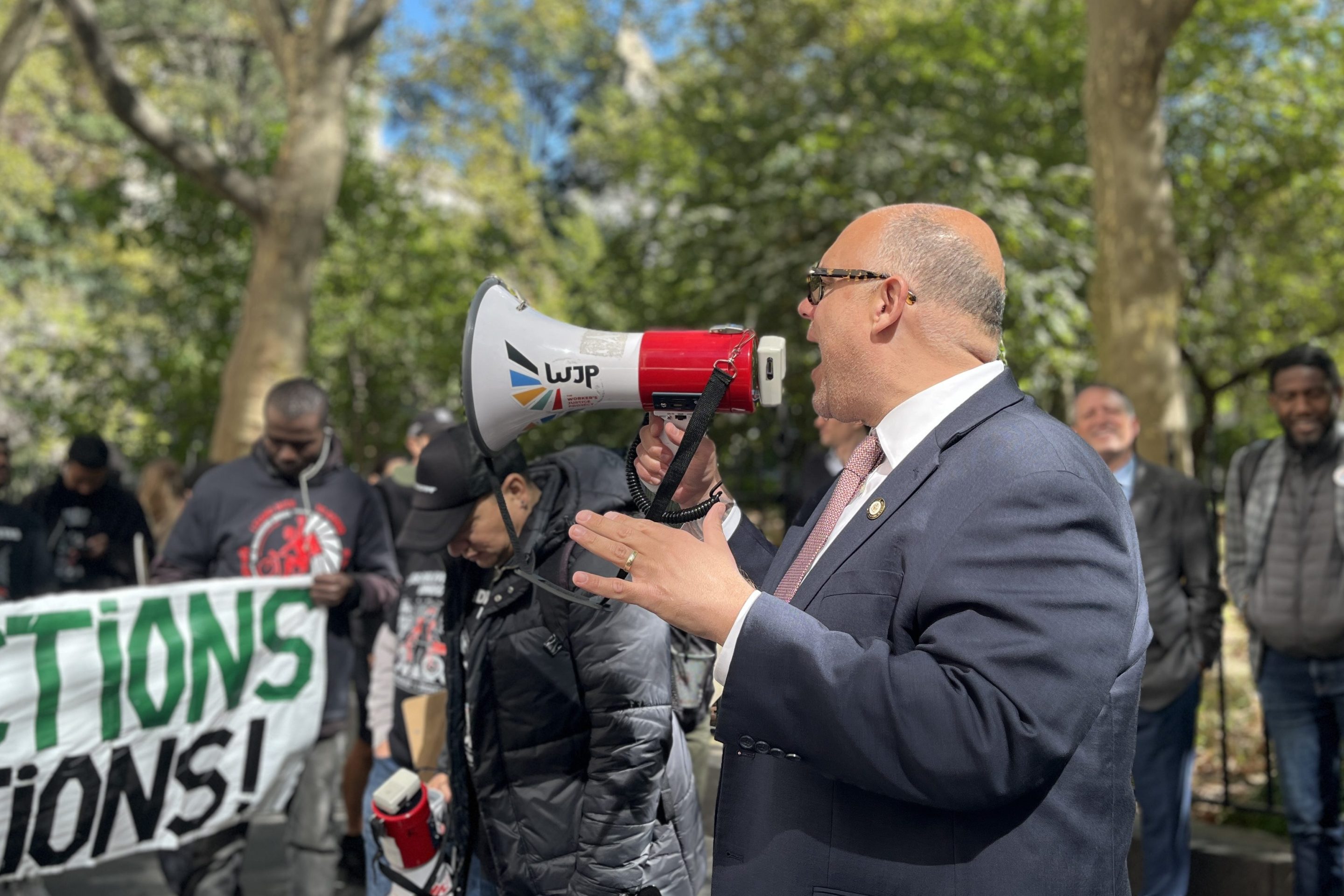Gov. Hochul has robbed the MTA's future... and its past.
Two MTA capital programs, the current 2020-2024 plan and upcoming 2025-2029 plan, now face massive funding gaps thanks to the Gridlock Gov's decision to jettison congestion pricing.
By making the $15 billion from congestion pricing an open question, Hochul opened a two-front war: The MTA has to replace the money it expected from congestion pricing for the current capital plan and find new sources of money for the next.
The two plans together fund transit essentials such as maintenance, signal modernization, accessibility upgrades and new trains and buses.
"You already have a financing problem for the next plan," Citizens Budget Commission President Andrew Rein told Streetsblog last week. "If you remove congestion pricing from the equation, your problem just got that much bigger for next time."
Hochul's 11th hour abandonment of the MTA's tolls, which were supposed to launch on June 30, was disastrous from a governing and environmental perspective. But it was also a catastrophic financial decision: As the MTA revealed last week, $16.5 billion in capital work can only be performed if there is money backed by congestion pricing to pay for it.
Without congestion pricing, the MTA needs to find $15 billion for its 2020-24 capital plan or cut back on its ambitious modernization efforts. Even then, it also needs somewhere in the neighborhood of $25 billion in new funding for the 2025-29 capital plan, the details of which the agency will reveal in September.
Since June 5, Hochul has insisted that everything is fine, and that she'll find alternative funding sources for the $15 billion that congestion pricing was supposed to provide. The governor has carried that attitude to discussions around the 2025-29 capital plan, as well.
"In the coming months, my team will work with the MTA to further develop a comprehensive approach to fund both the remaining projects in the 2020-24 capital plan and the new capital plan," the governor said in a statement on Wednesday after the MTA laid out the grim consequences of her decision.
The options for funding are theoretically endless. In reality, the governor's choices are constrained by the state's finances and politics.
"Other taxes come with the problem of needing to negotiate them through the budget process," said Reinvent Albany Senior Policy Analyst Rachael Fauss. "It's all hypothetical, speculative stuff that is not on paper yet, whereas congestion pricing is viable. It is the law. And there's one person standing in the way, not an army of lobbyists in Albany that might fight this or that tax."
New York State traditionally gives a contribution to the MTA capital plan, the largest of which was a $9-billion promise to the 2015-19 capital plan by disgraced former governor Andrew Cuomo. Since this is Hochul's war, can she end it herself with the biggest novelty check you've ever seen in your life?
Could Hochul one-up her former boss (and, per New York Magazine, the inspiration for her abandonment of congestion pricing) with a direct $40 billion contribution to the MTA, saving this and the next capital plan with the biggest state contribution to the authority's capital plan in history?
Well, probably not. Some kind of direct state appropriation was on the table in Albany at the end of the legislative session in June, but the total lack of details turned off legislators as well as budget-watchers who thought the idea was sloppily conceived.
New York State has a massive budget, but it also has massive needs to fill from the eastern tip of Long Island to Cape Vincent upstate. The state's total capital spending is set in five-year plans and relies on issuing billions of dollars in debt backed by tax money from around the state. Fiscal experts were skeptical of a fire-hose of money that would take away from other capital needs, dramatically raise the amount of debt the state carried or divert $40 billion from other needs.
"The state certainly can't be paying $40 billion cash over the next five years," said Rein.
Even if Hochul did decide she would be the governor who stepped up, a commitment that big may not be worth much. A huge chunk of Cuomo's contribution to the 2015-19 capital plan was MIA as late as mid-2019. About a billion dollars of the commitment still hasn't materialized, per the last funding update. The MTA, and anyone who wants to see the transit system brought into the modern age, would be putting a lot of trust in a governor who just lost a lot of trust from her last-minute reversal on congestion pricing.
The money would also be subject to "raids" from lawmakers for other uses, as it was several times under Cuomo, further endangering the MTA's capital efforts.
"That's your cautionary tale," Fauss said of Cuomo's as-yet-unfulfilled 2015-2019 commitment.
"The problem is, if you put a huge amount in, the state's not going to pony it all up at once, because [the state] has got a lot of capital needs. You're putting a lot of trust in the governor to have no temptation to raid the money in the budget."
If not a check, how about congestion pricing?
In her initial announcement of her "indefinite pause" of congestion pricing, Hochul stepped into, and quickly out of, the breach with a suggestion to raise the payroll mobility tax in New York City as a way to fill the $15-billion hole for the 2020-2024 plan. State lawmakers, who just raised the PMT to shore up the MTA's operating budget, balked at raising the tax on city businesses again to cover a congestion fee that would have been paid by people across the region.
More recently, former MTA Chairman Joe Lhota called for doubling the regional sales tax, which he called a "common sense" tax hike that would be much more popular than congestion pricing.
But both of those tax hikes need legislative approval and legislators, who passed congestion pricing in 2019 after years of debate over how to fund the current plan, haven't been keen to clean up a mess for the governor at the same time they have to figure out how to fund the next plan.
"What we discovered in the final week of session was that there's no easy answer, which is why the indefinite pause of congestion pricing is such a problem. That was something that took years to come to consensus around, and was filling a huge part of the MTA's capital budget needs," said Senate Deputy Majority Leader Mike Gianaris (D-Queens).
"Now you yank the rug out from that, none of the other options are appealing. They all have their own problems. And so we're back to square one."
The reversal of the outcome of the 2019 funding debate sets many Albany brains afire. The answer for which the governor is now scrambling was all set to start before she pulled the plug.
"We need to live in the real world here and talk about what's viable," said Fauss. "Congestion pricing is on the books, it's the law. It's ready to go. None of these other things are ready to go because they're subject to a ton of negotiation, and interest groups and the legislature."
"Maybe Kathy Hochul determined that congestion pricing wasn't viable for her," Fauss added, "but it's clearly viable for so many other reasons. It's the real real thing, it's here and it's ready."
The viability of congestion pricing went beyond the dollars it was set to provide. It was also the kind of funding stream that fit what budget watchers and the MTA itself look for when funding a capital plan.
Any replacement funding for congestion pricing needs to be a similarly long-term funding stream that's dedicated to the MTA so the agency could issued bonds against it, MTA Chief Financial Officer Kevin Wilens said last week.
"The most important characteristic is a recurring revenue stream that's dedicated for a long period of time because of course we're looking to bond it for the long term to raise the $15 billion," he said.
Like regional dedicated taxes, fares and tolls, congestion pricing was dedicated funding stream coming from people who benefit from the MTA, Rein said.
"Part of the genius of congestion pricing was making sure that drivers are part of that mix," said Rein. "The reality is drivers are already benefiting from the MTA tremendously, because it weren't for the MTA, we would have so many more cars on the road. There are the more broad-based benefits of reduced congestion and reduced emissions. Congestion pricing was the trifecta of benefits, and that still holds today."
The next hole
Funding the next capital plan was never going to be easy. The 20-Year Needs Assessment that the MTA shared last year in preparation for the 2025 plan and beyond was impressive in scope, but lacked details on costs.
MTA Chairman and CEO Janno Lieber has said he doesn't see the price of the new capital plan going down compared to the $55-billion 2020-2024 plan. State Comptroller Tom DiNapoli also forecasts the 2025-29 plan growing.
The 2020-2024 capital plan was supported by $15 billion in congestion pricing funds and $10 billion raised off an internet sales tax and a mansion tax in New York City. All of that money was to be directly sent to a "capital lockbox" to ensure any governor or legislature couldn't monkey around with it and divert it to other needs, and so the MTA couldn't divert it to the operating budget.
Without congestion pricing and the other capital fund lockbox money on which to rely, the MTA is starting off $25 billion short, DiNapoli warned just weeks before Hochul's announcement.
The governor's flip-flop on congestion could put the agency even further behind the 8-ball. Because it was a new, untapped revenue source to back up a loan, the MTA was going to be able to borrow off of congestion pricing while taking the pressure off of the bonds it financed using the money it raised from fare-backed tolls. But in response to the congestion pricing pause, Lieber has said that the MTA will need to turn to fare-backed bonds to raise capital money much earlier than planned — which could divert more money to paying off debt instead of putting it towards running trains and buses.
Instead of taking the pressure off of that debt-load the way congestion pricing borrowing could have, the MTA will be paying hundreds of millions of dollars more in borrowing fees, piling on to its mountain of fare-backed bond debt, which eats into operating costs. The agency also isn't going to see any congestion pricing ridership boost that would give it more revenue to support its borrowing costs.
"The MTA will have to issue debt sooner and there is likely a fare revenue impact," DiNapoli said in a statement to Streetsblog. "These will both affect the Authority’s operating budget and therefore how much it can ultimately issue in bonds."
The MTA's need to borrow based off of its own revenue earlier than it planned to also means that the agency is possibly limited in what it can bond out for its next capital plan. In its last three capital plans, the MTA included $8.2 billion, $12 billion and $10.7 billion of its own borrowing. But if the agency can't realistically hit that number, one of two things have to happen: Someone else has to fill that gap, or the capital plan shrinks and more work gets pushed to some uncertain future date.
Legislators who supported Hochul's pause haven't come to the governor's rescue with a funding package to fix either or both funding holes, and apparently neither had the governor even three weeks after she took an axe to the MTA's financial future. Assembly Speaker Carl Heastie has suggested everything will work out somehow.
I don’t know if anger is needed there. It will get figured out.
— Carl E. Heastie (@CarlHeastie) June 28, 2024
But the reality is that legislators aren't actually negotiating a new path forward, according to Gianaris. Whatever comes out of the rubble of Hochul's feckless decision make will ultimately be a rush-job, and far less stable than what she's abandoned.
"There's no real negotiations taking place at this point. I'm not sure the governor knows what her preferred solution is," said Gianaris. "It's not a good way to make decisions. The right way to make decisions is to think about things very deliberately, spend a fair amount of time studying an act, and then deal with any temporary and popularity because you know it's the right thing to do."
"That was congestion pricing," the senator added. "Now, we're left with a process that inevitably must be rushed."






